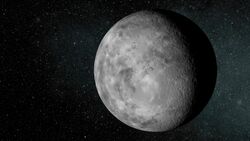Astronomy:Kepler-37b
 Artist's impression of Kepler-37b. | |
| Discovery[1] | |
|---|---|
| Discovery site | Kepler space telescope |
| Discovery date | February 20, 2013 |
| Transit | |
| Orbital characteristics[2] | |
| 0.1019±0.0014 astronomical unit|AU | |
| Eccentricity | <0.098 |
| Orbital period | 13.367020(60) d |
| Inclination | 88.63°+0.30° −0.53° |
| Star | Kepler-37 |
| Physical characteristics[2] | |
| Mean radius | 0.3098+0.0059 −0.0076 R⊕ |
| Mass | <0.79 M⊕[lower-alpha 1] |
| Physics | 718±10 K (445 °C; 833 °F, equilibrium) |
Kepler-37b is an exoplanet orbiting the star Kepler-37 in the constellation Lyra.[3] (As of February 2013), it is the smallest planet discovered around a main-sequence star, with a radius slightly greater than that of the Moon and slightly smaller than that of Mercury.[4] The measurements do not constrain its mass, but masses above a few times that of the Moon give unphysically high densities.[5]
Characteristics
Mass, radius and temperature
| Earth | Kepler-37b |
|---|---|

|
Kepler-37b is a sub-Earth, an exoplanet with a radius and mass smaller than Earth. Its equilibrium temperature is 718 K (445 °C; 833 °F).[2] Because of its small size, it is not expected to have an atmosphere.[6] Its radius is approximately 0.31 R⊕ (about 1,980 kilometres (1,230 mi)),[2] slightly larger than the Moon[7] (0.27 R⊕), but a little smaller than Mercury (0.38 R⊕). Due to its small size, it is very likely Kepler-37b is a rocky planet with a solid surface.[6] Furthermore, it is too hot to support liquid water on its surface.[6]
Host star
The planet orbits a (G-type) star similar to the Sun, named Kepler-37, orbited by a total of four planets. The star has a mass of 0.80 M☉ and a radius of 0.79 R☉. It has a temperature of, 5417 K and is 5.66 billion years old. In comparison, the Sun is 4.6 billion years old,[8] and has a temperature of 5778 K.[9]
The star's apparent magnitude, or how bright it appears from Earth's perspective, is 9.71. Therefore, it is too dim to be seen with the naked eye.[citation needed]
Orbit
Kepler-37b orbits its parent star at a distance of about 15 million kilometers (9.3 million miles), with a period of roughly 13 days at a distance of 0.1 AU (compared to Mercury's distance from the Sun, which is about 0.38 AU).[4] The outer two planets in the system have orbital periods[1][10] within one percent of the 8:5 and 3:1 resonances with Kepler-37b's period.
Discovery
Kepler-37b, along with two other planets, Kepler-37c and Kepler-37d, were discovered by the Kepler space telescope, which observes stellar transits.[1][6] After observing transits of Kepler-37b, astronomers had to compare it with the size of the parent star.
The size of the star was obtained using asteroseismology;[7] Kepler-37 is currently the smallest star to be studied using this process.[6] This allowed the size of Kepler-37b to be determined "with extreme accuracy".[6]
To date, Kepler-37b is the smallest planet discovered around a main-sequence star[lower-alpha 2] outside the Solar System.[4] Detection of Kepler-37b was possible due to its short orbital period, relative brightness, and low activity of its host star, allowing brightness data to average out quickly.[11] The discovery of Kepler-37b has led Jack Lissauer, a scientist at NASA's Ames Research Center, to conjecture that "such little planets are common".[6]
See also
Notes
- ↑ Masses more than a few times that of the Moon result in unphysically high densities.
- ↑ The pulsar planet PSR B1257+12 A has a comparable mass. The actual size of PSR B1257+12 A is unknown, but is likely comparable to Kepler-37b.
References
- ↑ 1.0 1.1 1.2 Barclay, T.; Rowe, J. F.; Lissauer, J. J.; Huber, D.; Fressin, F.; Howell, S. B.; Bryson, S. T.; Chaplin, W. J. et al. (2013-02-20). "A sub-Mercury-sized exoplanet". Nature 494 (7438): 452–4. doi:10.1038/nature11914. ISSN 0028-0836. PMID 23426260. Bibcode: 2013Natur.494..452B.
- ↑ 2.0 2.1 2.2 2.3 Bonomo, A. S. et al. (April 2023). "Cold Jupiters and improved masses in 38 Kepler and K2 small-planet systems from 3661 high-precision HARPS-N radial velocities. No excess of cold Jupiters in small-planet systems". Astronomy & Astrophysics. doi:10.1051/0004-6361/202346211.
- ↑ "Smallest Alien Planet Kepler-37b Explained (Infographic)". 20 February 2013. http://www.space.com/19858-smallest-alien-planet-kepler-37b-infographic.html.
- ↑ 4.0 4.1 4.2 "Tiniest Planet Yet Discovered by NASA Outside our Solar System". scienceworldreport.com. February 21, 2013. http://www.scienceworldreport.com/articles/5098/20130221/tiniest-planet-discovered-nasa-outside-solar-system.htm.
- ↑ Marcy, Geoffrey W.; Isaacson, Howard; Howard, Andrew W.; Rowe, Jason F.; Jenkins, Jon M.; Bryson, Stephen T.; Latham, David W.; Howell, Steve B. et al. (2014). "Masses, Radii, and Orbits of Small Kepler Planets: The Transition from Gaseous to Rocky Planets". The Astrophysical Journal Supplement Series 210 (2): 20. doi:10.1088/0067-0049/210/2/20. Bibcode: 2014ApJS..210...20M.
- ↑ 6.0 6.1 6.2 6.3 6.4 6.5 6.6 "NASA's Kepler Mission Discovers Tiny Planet System". NASA. February 20, 2013. http://www.nasa.gov/home/hqnews/2013/feb/HQ_13-057_Kepler_Tiny_Planet.html.
- ↑ 7.0 7.1 "Astronomers Find the Tiniest Exoplanet Yet". Slate. February 20, 2013. http://www.slate.com/blogs/bad_astronomy/2013/02/20/smallest_exoplanet_kepler_37b_is_barely_bigger_than_earth_s_moon.html.
- ↑ Fraser Cain (16 September 2008). "How Old is the Sun?". Universe Today. http://www.universetoday.com/18237/how-old-is-the-sun/.
- ↑ Fraser Cain (15 September 2008). "Temperature of the Sun". Universe Today. http://www.universetoday.com/18092/temperature-of-the-sun/.
- ↑ "Kepler-37 System". kepler.nasa.gov. http://kepler.nasa.gov/Mission/discoveries/kepler37/.
- ↑ "Small Planets Confirm Kepler's Capabilities". http://www.centauri-dreams.org/?p=26604.
| Records | ||
|---|---|---|
| Preceded by PSR B1257+12 A |
Least massive exoplanet[citation needed] 2013—2015 |
Succeeded by WD 1145+017 b |
| Preceded by Kepler-42 d |
Smallest-radius exoplanet 2013—2015 |
Succeeded by WD 1145+017 b |
Coordinates: ![]() 18h 56m 14.32s, +44° 31′ 05.3″
18h 56m 14.32s, +44° 31′ 05.3″
 |






